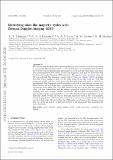Files in this item
Identifying solar-like magnetic cycles with Zeeman-Doppler-Imaging (ZDI)
Item metadata
| dc.contributor.author | Lehmann, Lisa Theres | |
| dc.contributor.author | Hussain, Gaitee Ara Jaffer | |
| dc.contributor.author | Vidotto, Aline | |
| dc.contributor.author | Jardine, Moira Mary | |
| dc.contributor.author | Mackay, Duncan Hendry | |
| dc.date.accessioned | 2020-10-21T16:30:03Z | |
| dc.date.available | 2020-10-21T16:30:03Z | |
| dc.date.issued | 2021-01 | |
| dc.identifier | 270819663 | |
| dc.identifier | d5a7f3a6-40ee-4f07-b257-11b556448350 | |
| dc.identifier | 85099941708 | |
| dc.identifier | 000599134600092 | |
| dc.identifier.citation | Lehmann , L T , Hussain , G A J , Vidotto , A , Jardine , M M & Mackay , D H 2021 , ' Identifying solar-like magnetic cycles with Zeeman-Doppler-Imaging (ZDI) ' , Monthly Notices of the Royal Astronomical Society , vol. 500 , no. 1 , pp. 1243–1260 . https://doi.org/10.1093/mnras/staa3284 | en |
| dc.identifier.issn | 0035-8711 | |
| dc.identifier.other | ORCID: /0000-0002-1466-5236/work/88730889 | |
| dc.identifier.other | ORCID: /0000-0001-6065-8531/work/88730923 | |
| dc.identifier.uri | https://hdl.handle.net/10023/20808 | |
| dc.description | Funding: UK Science & Technology Facilities Council (STFC) (ST/M001296/1) (MJM). UK STFC and the ERC (Synergy Grant: WHOLE SUN, Grant Agreement No. 810218) (DHM). | en |
| dc.description.abstract | We are reaching the point where spectropolarimetric surveys have run for long enough to reveal solar-like magnetic activity cycles. In this paper we investigate what would be the best strategy to identify solar-like magnetic cycles and ask which large-scale magnetic field parameters best follow a solar-type magnetic cycle and are observable with the Zeeman-Doppler-Imaging (ZDI) technique. We approach these questions using the 3D non-potential flux transport simulations of Yeates & Mackay (2012) modelling the solar vector magnetic field over 15 years (centred on solar cycle 23). The flux emergence profile was extracted from solar synoptic maps and used as input for a photospheric flux transport model in combination with a non-potential coronal evo- lution model. We synthesise spectropolarimetric data from the simulated maps and reconstruct them using ZDI. The ZDI observed solar cycle is set into the context of other cool star observations and we present observable trends of the magnetic field topology with time, sunspot number and S-index. We find that the axisymmetric en- ergy fraction is the best parameter of the ZDI detectable large-scale field to trace solar-like cycles. Neither the surface averaged large-scale field or the total magnetic energy is appropriate. ZDI seems also to be able to recover the increase of the toroidal energy with S-index. We see further that ZDI might unveil hints of the dynamo modes that are operating and of the global properties of the small-scale flux emergence like active latitudes | |
| dc.format.extent | 17846012 | |
| dc.language.iso | eng | |
| dc.relation.ispartof | Monthly Notices of the Royal Astronomical Society | en |
| dc.subject | Stars: activity | en |
| dc.subject | Stars: magnetic field | en |
| dc.subject | Stars: solar type | en |
| dc.subject | Methods: analytical | en |
| dc.subject | QB Astronomy | en |
| dc.subject | QC Physics | en |
| dc.subject | E-DAS | en |
| dc.subject.lcc | QB | en |
| dc.subject.lcc | QC | en |
| dc.title | Identifying solar-like magnetic cycles with Zeeman-Doppler-Imaging (ZDI) | en |
| dc.type | Journal article | en |
| dc.contributor.sponsor | Science & Technology Facilities Council | en |
| dc.contributor.sponsor | European Research Council | en |
| dc.contributor.institution | University of St Andrews. Applied Mathematics | en |
| dc.contributor.institution | University of St Andrews. School of Physics and Astronomy | en |
| dc.identifier.doi | https://doi.org/10.1093/mnras/staa3284 | |
| dc.description.status | Peer reviewed | en |
| dc.identifier.grantnumber | ST/S000402/1 | en |
| dc.identifier.grantnumber | 810218 | en |
This item appears in the following Collection(s)
Items in the St Andrews Research Repository are protected by copyright, with all rights reserved, unless otherwise indicated.

